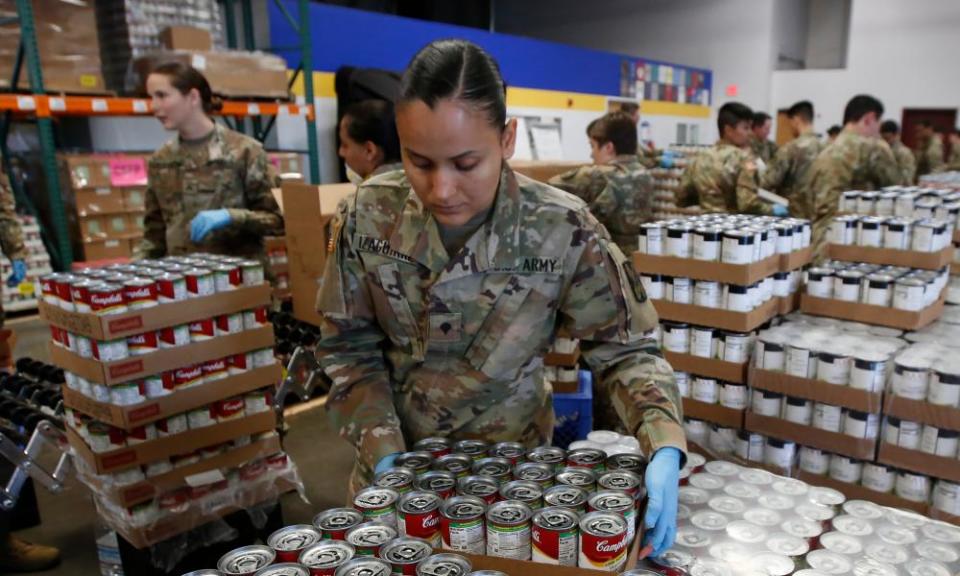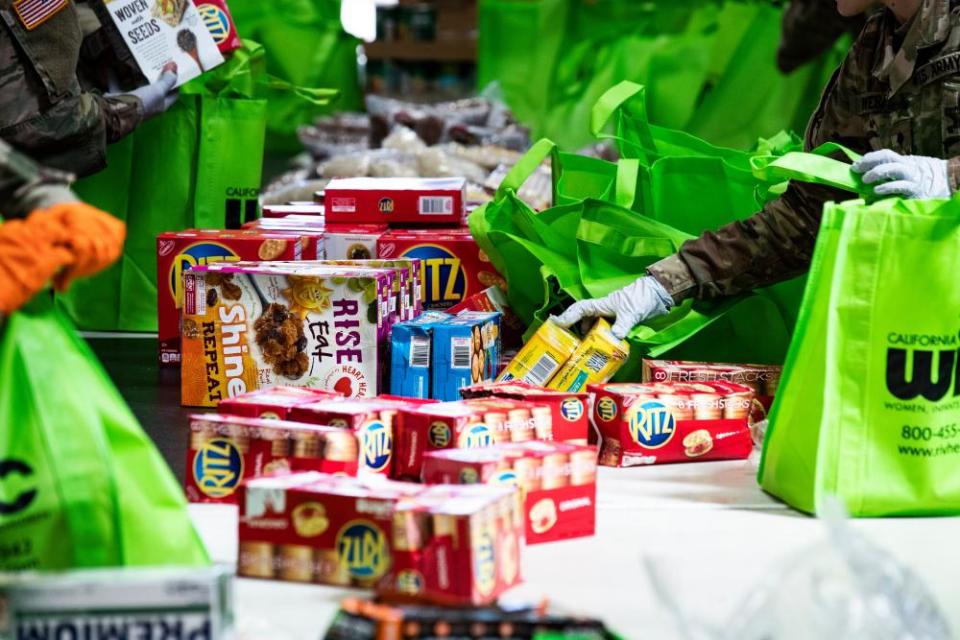California's food banks grapple with 'tsunami of need' as pandemic grows

On a bright spring afternoon, hundreds of cars snaked up and down the parking lot in front of a community college in the industrial suburb of Pittsburg, California. One by one, students, teachers, young families and groups of elderly neighbors pulled up to visit a makeshift emergency food bank.
To minimize the risk of spreading coronavirus, workers from the food bank asked drivers to pop open their trunks so they could drop in a sack of produce and a box of pantry staples.
“This is my first time ever coming to a food bank,” said Dalia Garcia, as she drove through in an SUV with her husband, baby and mother. “I didn’t need it before,” she said as she collected a flyer explaining how to sign up for the state food benefits program. The pandemic put the 26-year-old hairdresser out of work. “I found out this was happening on Facebook, and I’m glad it’s here,” she said.
A few cars down, Terri Birdzull, 59, agreed. “This is really needed,” she said. “There’s nothing at the stores! And if there is, it’s only the most expensive stuff left over.”
The event was organized by the Food Bank of Contra Costa and Solano, part of the national Feeding America network of food charities, to meet a sudden, unprecedented need. The demand for food aid has increased as much as eightfold in some areas, according to an investigation by the Guardian.
Related: 'A perfect storm': US facing hunger crisis as demand for food banks soars
In California, despite efforts from federal and state governments to free up emergency food stores and mobilize the national guard to pack and distribute groceries, advocates worry about keeping apace as the logistics of feeding the hungry become more complicated.
When Leslie Bacho and the staff at the Second Harvest food bank in California’s Bay Area developed a disaster plan not too long ago, they planned for a big earthquake, widespread wildfires and other natural disasters. “Global pandemic was not even on the list of what we were thinking about,” Bacho said. “What we’re facing right now is truly unprecedented.”
After a natural disaster, local food banks are usually able to call upon other charities, based in unaffected areas, to send staff and supplies, she said. “But everybody is facing this pandemic at the same time,” she added.
Even before coronavirus hit California, Second Harvest was aggressively fundraising, in order to feed the hundreds of thousands of families struggling to survive in one of the most expensive regions of the US. “Now,” she said, “it’s really like a tsunami of need suddenly hitting.”
Across the state, food banks said they were scrambling to meet the need, even as the pandemic and distancing measures to mitigate the spread of disease created hurdles.
Grocery stores and food manufacturers – which routinely donate excess produce and staples – are now giving less food, due to higher demands from consumers stockpiling, said Paul Ash, executive director of the San Francisco-Marin food bank. “We’re probably going to have to buy more food than we would,” he said.
The costs of certain staples are rising as well. As Americans hunker down and stock up their larders, the wholesale price of common “midwest large” eggs was triple what it was in early March. Such cost increases have already hit food banks, which are depleting their budgets as they buy more to keep up with demand.

“We are ramping up our purchasing, and we’re buying in bulk,” said Michael Altfest, at the Alameda County Food Bank, which serves parts of the East Bay region. “Right now what we need is money.”
Distributing the food has also proved to be a challenge, as soup kitchens and free pantries across the country close down. Many of these distribution sites were based at schools, which have now been shut. “On day one of school closures, we lost access to 45 distribution sites,” said Ash. Some of those schools have allowed food banks to use the grounds to set up food distribution centers. “But still, we have been scrambling to provide alternate sites and publicize the information,” he said.
Another reason for the closures is a lack of volunteers. The seniors and retirees who normally pitch in have been told to shelter at home to avoid contracting coronavirus. Corporate groups and students – who would often show up in big groups to help out – are unable to volunteer as much, with colleges shut and companies mandating that staff work from home, Ash said.
Related: What US unemployment benefits can I get during the coronavirus? Your payment options explained
In response to volunteer shortages in California, the governor, Gavin Newsom, enlisted the state’s national guard to help food banks package food for distribution. But staff at the state’s largest food banks said they were worried about how they would keep up with thousands who had never needed assistance before. “The thing is we don’t know how long we’ll have this help,” said Cassidie Carmen Bates at the Food Bank of Contra Costa and Solano. “And with that demand growing so quickly, we don’t know how much longer we’ll be able to put out food at this rate.”
Guardsmen had helped pack the weighty box that Roxana Samayoa, 38, struggled to carry back home after stopping by the emergency distribution center in Pittsburgh. “I never thought we’d need food like this,” said Samayoa. She came to the US from El Salvador a year ago, along with her husband and three children, fleeing violence. “We were professionals there. My husband was a lawyer, and I a teacher,” she said in Spanish. Now, her husband – who had been working as a gardener – has been put out of work. And the preschool where she’d been helping out has closed. “I came here seeking safety,” she said. “But now I don’t feel safe.”

